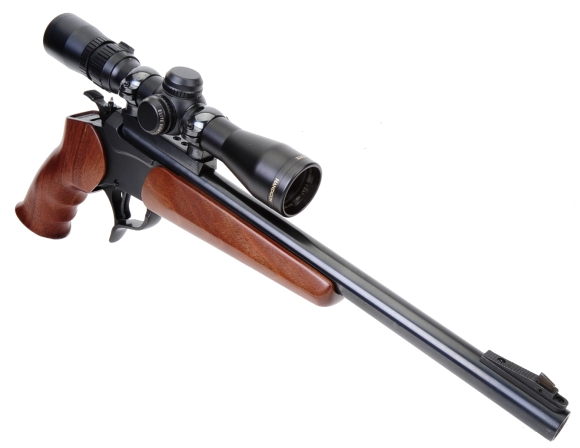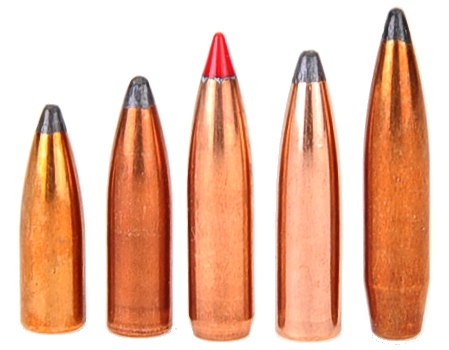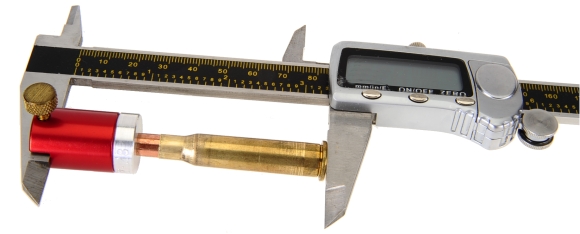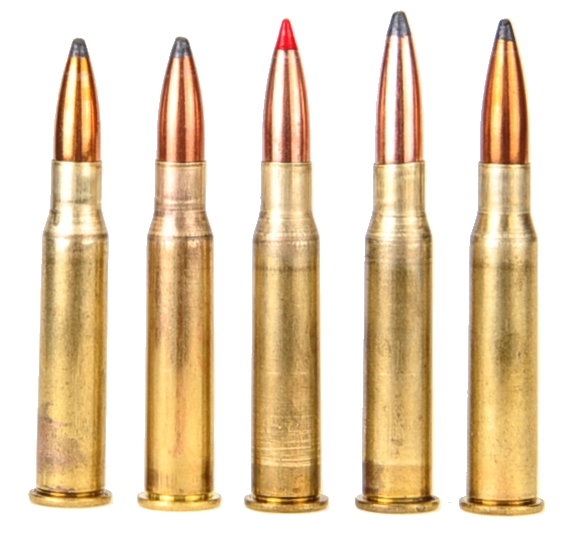
I have to say, this project really renewed my interest in the Thompson/Center Contender. It reacquainted me with its recreational potential, its usefulness as a hunting firearm, its portability, and its accuracy. Subsequently, my own Contender is out of storage and the subject of a series of related projects that will appear on Real Guns®.
In preparation for this last segment, a Leupold base and rings were installed, along with a Bushnell long eye relief handgun scope. The barrel under the rear metallic sight is drilled and tapped for scope mounts; metallic sight removal is easy and base/rings are an easy install. Using a pistol scope does not come natural to me. I have to get my brain connected to the visuals, I have to work more at muscle control and concentration, but I always rewarded with the way it enhances my reach and accuracy.
A few tweaks to handloads…
Lead tip bullets tend to vary in length, noticeably, even as a result of bouncing around in handling. A bullet comparator uses a stable reference point on a bullet’s jacket to eliminate the lead tip variable. An O.A.L. gauges determines maximum bullet projection from a case, the comparator measures the resulting length from a reliable reference point, a small amount if reduced from that measurement to provide rifling clearance, and the seater die is adjusted to match that dimensional conclusion. The comparator measurement was added to the spec box below.

| Bullet | Type | Weight Grains |
Length” | Contact OAL Length ” |
Load OAL Length “ |
0.280″ Comparator OAL |
| Sierra Pro-Hunter | SPFB | 120 | 0.975 | 2.810 | 2.750 | 2.245 |
| Speer Hot-Cor | SPFB | 145 | 1.110 | 2.790 | 2.770 | 2.295 |
| Nosler Ballistic Tip | PTBT | 150 | 1.310 | 2.890 | 2.870 | 2.300 |
| Speer Hot-Cor | SPFB | 160 | 1.230 | 2.935 | 2.915 | 2.335 |
| Sierra-Game King | SPBT | 175 | 1.410 | 2.885 | 2.865 | 2.300 |
Assembled, they look as they appear below; on the table top to bottom, in the picture left to right. Dies used were Lee Precision full length sizer, seater and collet crimp die, mostly just to keep the case mouth neat.

Powder selections were the best of what was tried, so there is a combination of established as well as newer releases. I found much of the 7-30 Waters mainstream manual data to be a bit dated, however, Speer #15 seems to have the cartridge well covered.
Warning: Bullet selections are specific, and loads are not valid with substitutions of different bullets of the same weight. Variations in bullet length will alter net case capacity, pressure and velocity. Primer selection is specific and primer types are not interchangeable. These are maximum loads in my firearms and may be excessive in others. All loads should be reduced by 5% as a starting point for development where cartridges have greater than 40 grains in capacity and 10% for cartridges with less than 40 grain capacity following safe handloading practices as represented in established mainstream reloading manuals. Presentation of these loads does not constitute a solicitation for their use, nor a recommendation.
| Cartridge 7-30 Waters |
|
| Firearm | T/C Contender G2 |
| Barrel Length | 14.00″ |
| Min – Max Case Length | 2.040″ +0.000″/-0.020″ |
| Min – Max COL | 2.480″ – 2.550″ |
| Primer | Remington 9 1/2 |
| Bullet Diameter | 0.2845″ +0.000″/-0.0030″ |
| Reloading Dies | Lee Precision |
| Bullet Type | Bullet Weight Grains |
Net H2O Grains Capacity |
COL” | Powder Type | Powder Charge Grains |
Muzzle Velocity fps |
Muzzle Energy ft/lbs |
100 YD 3 Shot Group “ |
| Sierra Pro-Hunter |
120 | 39.8 | 2.750 | AA2520 | 37.0 | 2438 | 1584 | 0.9 |
| Sierra Pro-Hunter | 120 | 39.8 | 2.750 | AR-Com | 34.0 | 2398 | 1533 | 0.8 |
| Sierra Pro- Hunter | 120 | 39.8 | 2.750 | CFE223 | 38.5 | 2380 | 1510 | 1.2 |
| Speer | 145 | 39.9 | 2.770 | AR-Comp | 31.5 | 2193 | 1549 | 1.0 |
| Speer | 145 | 39.9 | 2.770 | Re15 | 34.5 | 2165 | 1510 | 0.7 |
| Speer | 145 | 39.9 | 2.770 | IMR 748 | 34.0 | 2258 | 1642 | 1.2 |
| Nosler Ballistic Tip | 150 | 36.6 | 2.870 | AA2520 | 33.5 | 2259 | 1700 | 0.8 |
| Nosler Ballistic Tip | 150 | 36.6 | 2.870 | Re15 | 33.5 | 2115 | 1490 | 1.1 |
| Nosler Ballistic Tip | 150 | 36.6 | 2.870 | CFE223 | 35.0 | 2209 | 1626 | 0.9 |
| Speer | 160 | 38.3 | 2.915 | AA2520 | 34.0 | 2220 | 1751 | 0.6 |
| Speer | 160 | 38.3 | 2.915 | AR-Comp | 31.0 | 2083 | 1542 | 1.2 |
| Speer | 160 | 38.3 | 2.915 | CFE223 | 35.5 | 2140 | 1627 | 1.0 |
| Sierra | 175 | 35.5 | 2.865 | AA2520 | 31.0 | 2027 | 1597 | 1.1 |
| Sierra | 175 | 35.5 | 2.865 | Re15 | 31.0 | 1906 | 1412 | 1.0 |
| Sierra | 175 | 35.5 | 2.865 | CFE223 | 33.0 | 2063 | 1654 | 1.3 |
A heavier bullet perspective…
The sole factory load for the 7-30 Waters is 120 grains. My experience with 7mm cartridges; 7mm-08 Rem, 7x57mm Mauser, 7mm Rem Mag and woodland hunting has always led me away from the light end of the 7mm bullet spectrum and onto the middle and heavy weights. What I did find is that many of the bullets I’ve selected for the 7mm Rem Mag work as well when loaded in the significantly lower velocity 7mm-08 Rem and 7x57mm Mauser… which conventional wisdom says is incorrect as these bullets are made to withstand magnum velocity levels.
A 160 grain bullet fired from a 24″ barrel 7mm Rem Mag has a muzzle velocity of approximately 2,900 fps, while the 160 grain bullet from the 14″ barrel 7-30 Waters has a muzzle velocity of 2,220 fps. Fortunately, game is rarely shot at the muzzle and the 7mm Rem Mag is intended to shoot game at a distance, while the Contender and 7-30 Waters are made for more moderate ranges… inside 150 yards within the project’s hypothetical confines. What matters, in terms of a bullet properly expanding, is how fast the bullet is traveling on impact. A bullet that will expand at 400 yards with the 7mm Rem Mag where it is traveling 2,200 fps will expand at 2,000 fps at 100 yards as a bullet from a 7-30 Waters, particularly if a bullet is intended for thin skinned, medium to large size game. The bullets listed on the table above are not made for shooting brown bear with the 7mm Rem Mag; no Nosler Partitions, no Swift A-frames, no Speer Grand Slams.
In Cartridges of the World, the suggestion is made that the 7-30 Waters can not deliver the down range performance of the 30-30 WCF. Winchester 170 grain 30-30 WCF ammunition is listed with a 2,200 fps muzzle velocity from a 24″ SAAMI standard test barrel. The Thompson / Center Contender produces 2,220 fps of muzzle velocity with a 160 grain bullet and the spire tipped Contender bullet better retains performance down range. Optimal trajectory for each was calculated for best zero with a 6″ critical target.
| 160 Grain 7-30 Waters Vs 170 Grain 30-30 WCF | ||||||||
| Yards | 0 | 50 | 100 | 150 | 200 | 250 | 300 | |
| 7-30 Waters Velocity – fps | 2220 | 2145 | 2071 | 1999 | 1929 | 1860 | 1792 | |
| 30-30 WCF Velocity fps | 2200 | 20147 | 1901 | 1762 | 1629 | 1507 | 1394 | |
| 7-30 Waters Energy – ft.-lbs. | 1915 | 1787 | 1667 | 1553 | 1445 | 1344 | 1248 | |
| 30-30 WCF Energy ft-lbs | 1827 | 1582 | 1364 | 1171 | 1002 | 857 | 734 | |
| 7-30 Waters Momentum lbs-sec | 56 | 54 | 52 | 50 | 48 | 46 | 45 | |
| 30-30 WCF Momentum lbs-secs | 53 | 50 | 46 | 43 | 40 | 37 | 34 | |
| 7-30 Waters Path – In. | -1.50 | 1.93 | 3.46 | 2.97 | 0.31 | -4.69 | -12.20 | |
| 30-30 WCF Path-In. | -1.50 | 1.78 | 2.99 | 1.79 | -2.22 | -9.51 | -20.63 | |
A lighter bullet perspective…
Some folks like light bullets for the increased muzzle velocity they bring. For me, light bullets don’t seem to offer any advantage over the 160 grain bullet and, in fact, fall short in a number of areas. I am not suggesting there is no place for the lighter side of 7mm bullet weights, but I am suggesting they don’t necessarily fit for deer hunting. other than initially higher velocity, their light weight does not offer sustained higher velocity over 1 160 grain bullet, which means they also do not offer higher kinetic energy or momentum.
| 120 Grain 7-30 Waters | ||||||||
| Yards | 0 | 50 | 100 | 150 | 200 | 250 | 300 | |
| Velocity – fps | 2438 | 2310 | 2185 | 2065 | 1949 | 1837 | 1729 | |
| Energy – ft.-lbs. | 1583 | 1421 | 1272 | 1136 | 1012 | 899 | 796 | |
| Momentum – lbs-sec | 42 | 40 | 37 | 35 | 33 | 31 | 30 | |
| Path – in. | -1.50 | 1.52 | 2.91 | 2.47 | 0.00 | -4.76 | -12.10 | |
The Thompson/Center Contender in conclusion…
The T/C Contender brings value and flexibility to a hunting firearm and a great deal of potential for the handloader. Coupled with the 7-30 Waters, or anyone of the deer class centerfire cartridges offered, the pistol can generate an extra burst hunting season enthusiasm and some new challenges for even the experienced hunter. For recreational or competitive target work, the Contender is a consistently accurate firearm and capable of shooting over longer distances. It can be purchased as a frame and barrel combination and used for a specific purpose. It can also be purchased as a component of a system with a variety of barrels and stocks added over time as applications develop. Nice gun.

Email Notification